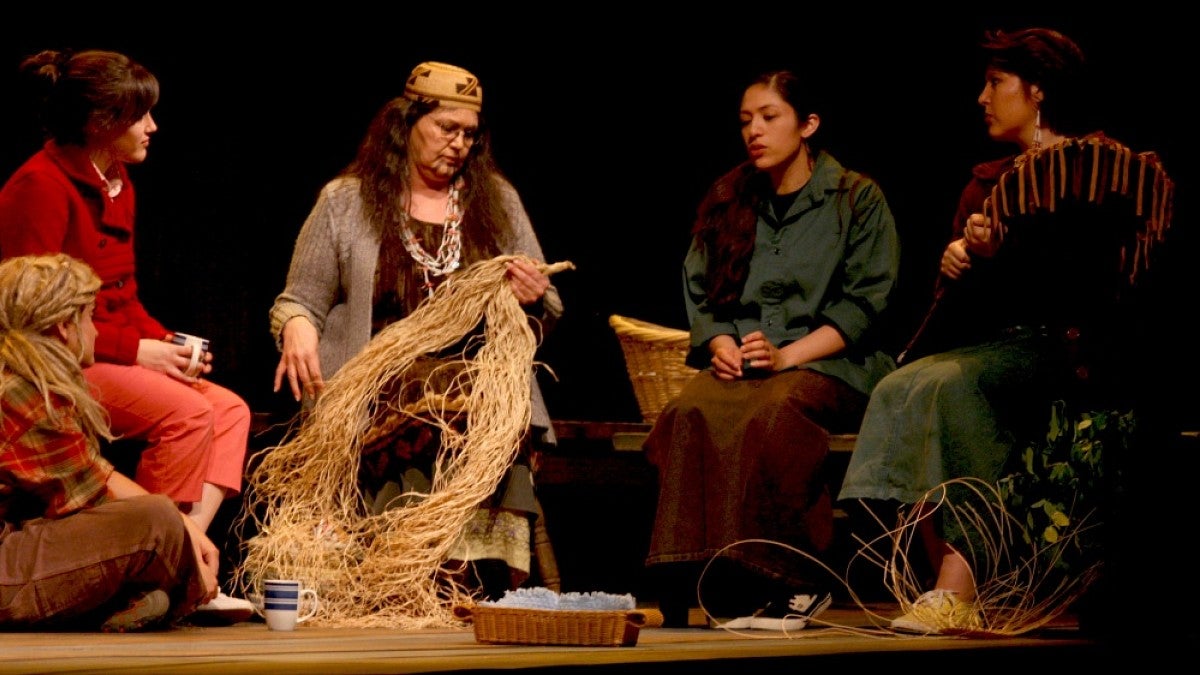A unique partnership between a Department of Theatre Arts professor, director and playwright and a Grand Ronde tribal elder and actor has given Native theater a voice and a presence on campus.
Their collaboration resulted in one new play that brought a tribal perspective to one of the Northwest’s most significant environmental disasters, and a second play is now in the works. The partnership also has given students the opportunity to see theater through Native eyes and brought a spotlight to work by Indigenous playwrights.
In 2011, UO theater professor Theresa May staged “Salmon Is Everything” — the story of the 2002 Klamath River fish kill of 60,000 spawning salmon, which hurt tribes on the Lower Klamath River whose culture and livelihood depended on them — to the UO’s Robinson Theatre. She wrote the play in collaboration with Native citizens of the Klamath River watershed, including Karuk, Yurok, Hoopa Valley and Klamath tribal members. It’s since been published by Oregon State University Press.
The production was the start of a long-lasting collaboration between May and Marta Clifford, who played a Karuk grandmother in the play and is a Grand Ronde elder with Chinook and Cree heritage. Since then, they have taught courses in contemporary Native theater as well as presented public programs focused on plays and performances by Native and First Nations dramatists.
Clifford’s role as elder in residence in May’s classes is supported by the Office of the Provost and through a Tom and Carol Williams grant awarded to the Department of Indigenous, Race and Ethnic Studies.
May values Clifford’s presence in the class because she is able to “authoritatively and compassionately help non-Native students understand Oregon Native history and move beyond their emotions to proactive allyship.”
“I’m there to answer questions that cannot be answered from a book or by somebody who is a non-Native person,” Clifford said. The pair has also coauthored articles about their productive relationship.
Their current project, “BlueJay’s Canoe,” began with a particular iteration of their Native theater class in which students studied script development, conducted research on Oregon tribal histories and environmental restoration, and listened to elders and other guest speakers from Oregon’s nine federally recognized tribes. The ongoing development of the play has been supported by the Center for Environmental Futures and the Center for the Study of Women in Society.
The play is a coming-of-age story about a high school student who interns at a Willamut Valley radio station for a DJ with a mysterious past. The play uses the Kalapuya spelling of Willamette. Clifford will play Goldie, a Native elder and a role she created from her own childhood memories.
Native history, culture and activism are intertwined within the plot and the character’s backstories as Native histories collide with a pandemic in a year overflowing with challenges and tragedy.
“This is a way to give a Native perspective,” Clifford said. “A lot of people still view Native people as a culture ‘of the past.’ The play shows them that, yes, Native people lived here in the past, but look, here’s a local Native guy running a radio station. He and his aunt Goldie tell stories that teach viewers about local Native history and culture, such as the importance of canoes and that camas was a major food source for the Native people in the Willamut valley.”
Although still a work in progress, May and Clifford hope that “BlueJay’s Canoe” will be staged by University Theatre or a local theater next year. With Lori Tapahonso, steward of the Longhouse at Lane Community College, they have started a company called illioo Native Theatre to produce works by Native dramatists and to model Native/non-Native partnerships.
“Theatre is both alive and communal; right there before our eyes we witness embodied stories, and we do it together,” May said. “In this way, as First Nations dramatist Monique Mojica writes, theater has a power to ‘spin new worlds into being.’ This is how theater can help generate a future that is just, compassionate and sustainable.”
—By Sharleen Nelson, University Communications


